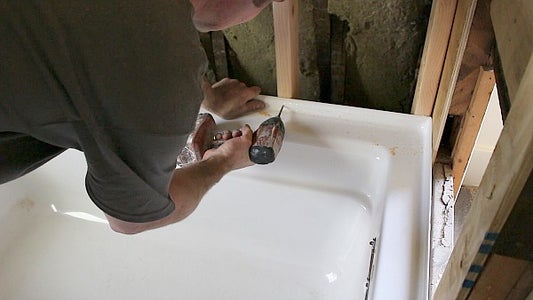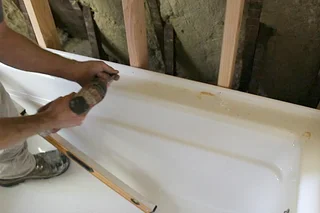The Foundation of Plumbing Skills When Installing a Bathtub
The Foundation of Plumbing Skills When Installing a Bathtub
Blog Article
We have discovered the article about How to Install a Bathtub Yourself directly below on the web and figured it made perfect sense to write about it with you in this article.

Installing a tub isn't specifically brain surgery, yet it does require strong plumbing, woodworking, and also occasionally, tiling skills. Changing an old bathtub with a brand-new one is additionally a moderately challenging job. If the old bathtub is conveniently available, the task can relocate rapidly; if you need to open a wall surface to remove the old tub and also position the new tub, the job is a lot harder. In either instance, the job is within a home handyman's abilities, although you will certainly need a helper to vacate the old tub and embeded in the new one. Make sure you have actually certified yourself for the job and fit attempting it. Rather than working with a professional to take over a halfway-completed project, it is much better to think about using one prior to you begin. Possibilities are you might require an expert plumber to make tube links.
This short article will certainly aid you set up a new tub in your bathroom if you have actually currently purchased a brand-new tub and also don't need to change the arrangement of your previous water pipelines.
Your devices and material list ought to consist of the following:
Removing Old Taps
If you need to replace old taps with brand-new ones as a part of your setup, after that the first thing you should do is disconnect the water. After doing so, switch on the taps to drain pipes any kind of water continuing to be in the system. The process of removing the existing taps can be fairly bothersome because of the limited gain access to that is typically the case.
Utilize a basin wrench (crowsfoot spanner) or a faucet tool to undo the nut that links the supply pipelines to the taps. Have a fabric prepared for the continuing to be water that will come from the pipelines. As soon as the supply pipes have been removed, utilize the exact same tool to loosen up the nut that holds the taps onto the bath/basin. You will need to stop the single taps from turning during this procedure. As soon as the faucets have actually been eliminated, the holes in the bath/basin will certainly have to be cleansed of any old sealing compound.
Prior to going on to fit the new taps, compare the pipeline connections on the old taps to the brand-new faucets. If the old faucets are longer than the new taps, after that a shank adapter is required for the new taps to fit.
Suitable New Touches
If the tails of the brand-new taps are plastic, after that you will certainly require a plastic connector to stop damages to the thread. One end of the adapter fits on the plastic tail of the tap and also the other end gives a connection to the existing supply pipelines.
If you need to fit a monobloc, after that you will certainly require lowering couplers, which links the 10mm pipeline of the monobloc to the conventional 15mm supply pipeline.
Next off, position the tap in the installing hole in the bath/basin making certain that the washing machines are in place between the tap and the sink. Secure the tap in place with the producer supplied backnut. When the tap is safely in place, the supply pipes can be attached to the tails of the faucets. The faucets can either be attached by utilizing corrugated copper piping or with normal tap ports. The previous kind ought to be connected to the faucet finishes first, tightening only by hand. The supply pipes can later on be linked to the other end. Tighten both ends with a spanner after both ends have been linked.
Installing the Bath tub
Utilizing the two wooden boards under its feet, position the tub in the required setting. The wood boards are practical in evenly spreading out the weight of the bath tub over the area of the boards as opposed to focusing all the weight onto four little factors.
The following goal is to make sure that the bath tub is leveled all round. This can be achieved by checking the spirit level as well as readjusting the feet on the bath tub till the spirit level reads level.
To install taps, fit the bottom of the furthest flexible tap connector to the appropriate supply pipe by making a compression sign up with; after that do the very same for the various other tap.
Turn on the water system as well as check all joints and brand-new pipework for leaks and tighten them if required. Fill the bath tub and likewise inspect the overflow outlet and the typical electrical outlet for leakages.
Finally, take care of the bathroom paneling as defined in the manufacturer's instruction manual. Tiling as well as securing around the tub ought to wait up until the bath tub has been used at the very least once as this will certainly settle it into its last position.
Getting ready for the Installation
First of all, the sustaining structure supplied with the bath ought to be fitted (if called for) according to the supplier's instructions. Next, fit the taps or mixer to the bathtub. When fitting the tap block, it is very important to see to it that if the faucet features a plastic washing machine, it is fitted in between the bathroom as well as the taps. On a plastic bath, it is also reasonable to fit a sustaining plate under the faucets system to prevent pressure on the bath tub.
Fit the versatile tap connectors to the bottom of both taps using 2 nuts as well as olives (in some cases supplied with the tub). Fit the plug-hole outlet by smearing mastic filler round the sink outlet opening, and then pass the outlet through the hole in the bath. Use the nut supplied by the producer to fit the plug-hole. Analyze the plug-hole outlet for an inlet on the side for the overflow pipeline.
Next, fit completion of the flexible overflow pipe to the overflow electrical outlet. Afterwards, screw the pipe to the overflow face which must be fitted inside the bathroom. Make sure you utilize every one of the provided washing machines.
Attach the trap to the bottom of the waste outlet on the bathtub by winding the thread of the waste outlet with silicone mastic or PTFE tape, as well as screw on the catch to the electrical outlet. Link all-time low of the overflow tube in a comparable manner.The bathroom must now be ready to be suited its last setting.
Tiling Around the Bathtub
In the location where the bathroom meets the floor tile, it is needed to seal the accompanies a silicone rubber caulking. This is necessary as the installation can move sufficient to crack an inflexible seal, triggering the water to pass through the wall in between the bath as well as the tiling, resulting in difficulties with moisture and also possible leaks to the ceiling listed below.
You can choose from a range of coloured sealers to assimilate your fixtures and installations. They are sold in tubes as well as cartridges, and are capable of securing voids up to a width of 3mm (1/8 inch). If you have a larger void to load, you can load it with spins of soaked newspaper or soft rope. Remember to constantly load the bathtub with water before securing, to allow for the motion experienced when the tub is in use. The sealant can crack fairly early if you do not consider this movement prior to securing.
Additionally, ceramic coving or quadrant ceramic tiles can be used to border the bathroom or shower tray. Plastic strips of coving, which are easy to use and reduce to dimension, are also conveniently offered on the market. It is advisable to fit the ceramic tiles using waterproof or waterproof glue and cement.
Bathtub Installation
How Important Is A Bathtub To Your Home?
High-quality baths, showers, and other bathroom updates are necessary when considering a smart investment in your home. It’s a room that you go to every day and one that is constantly being used by guests.The bathroom is one of the top trafficked rooms in a home and also one of the most valuable in terms of home resale.
Install Piping Before Tub
You will be using your existing drain and waste vent system, but pipes required include the hot and cold water supply lines and a pipe leading to a shower head. A mixing valve and shower head are also needed. Air chambers may be required.
Position the Tub
Lower the tub into place so that the continuous flange fits against the wall studs and rests on 1’x4' or 2’x4' supports. Anchor the tub to the enclosure with nails or screws inserted through the flanges into the studs.
NOTE: Remember, bathtubs and shower stalls may require support framing. A bathtub filled with water is extremely heavy, so check building codes and framing support before installing the tub.
Assemble Drain Connections
Assemble the bathtub drain connections by connecting the tub overflow with the tub drain above the trap, not beyond it. The trap will have a compression fitting that screws over the arm of the overflow assembly.
Place a Pipe For the Shower Head
First, locate a brass female threaded winged fitting and attach it to a framing support via a screw or a nail. Then run a pipe up the wall for the shower head. Sweat or solder the other side of the brass fitting to the top of the pipe.
Attaching Hot and Cold Water Lines
Attach your water lines for both hot and cold by sweating these directly into the hot and cold ports of the mixing valve. The mixing valve will be how water enters the tub’s system, not by the pipes themselves.
Install the Spout
Extend a piece of 1/2 inch pipe, or whichever length is specified in the manufacturer’s instructions, for the tub spout. Sweat on a male threaded fitting at the end of the pipe or use a brass nipple of the proper length and a 1/2 inch cap.
NOTE: At this point you should have your rough-in plumbing work inspected before proceeding further.
Check For Leaks
Restore the water pressure and check the drain connection and the supply pipes for any sign of leaking.
estore the Bathroom Wall
Replace the wall with moisture-resistant drywall as a base for your wall covering. Seal the joints between the wall and your new tub with silicone caulk as protection against water seepage.
https://www.berkeys.com/2016/12/02/bathtub-installation-dallas/

I stumbled upon that piece about How to Install a Bathtub: Install an Acrylic Tub and Tub Surround when browsing the internet. So long as you enjoyed our page plz make sure you remember to share it. I love reading our article about A Step-by-Step Guide to Installing a Bathtub.
Details Report this page